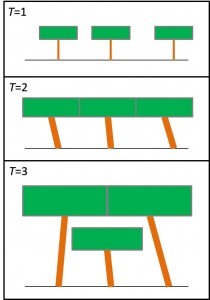New finding helps explain rainforests’ influence on global climate

By Catherine Zandonella, Office of the Dean for Research
Despite their diversity, the structure of most tropical rainforests is highly predictable. Scientists have described the various sizes of the trees by a simple mathematical relationship called a power law.
In a new study using data from a rainforest in Panama, researchers determined that competition for sunlight is the underlying cause of this common structure, which is observed in rainforests around the globe despite differences in plant species and geography. The new finding can be used in climate simulations to predict how rainforests absorb excess carbon dioxide from the atmosphere.
The study, conducted by researchers at Princeton University, the National Institute for Mathematical and Biological Synthesis, the Smithsonian Tropical Research Institute and collaborating institutions, was published Jan. 8 in the journal Science. The investigation was supported in large part by the National Science Foundation.

The researchers found that the rainforest structure stems from what happens after a tall tree falls and creates a gap in the canopy. The gap enables sunlight to reach the forest floor and fuel the rapid growth of small trees. Over time, the trees’ crowns grow to fill the gap until the point where not all of the trees can fit in the sunlit patch. Some will be left behind in the shade of their competitors.
“This process of moving from fast growth in the sun to slow growth in the shade sets up this characteristic size structure that is common across tropical rainforests, despite the differences in their environments,” said Caroline Farrior, first author of the study who is a postdoctoral fellow at the National Institute for Mathematical and Biological Synthesis and will soon be an assistant professor of integrative biology at the University of Texas-Austin.
Farrior, who earned her Ph.D. in ecology and evolutionary biology from Princeton University in 2012, completed most of the work as a postdoctoral researcher in the Princeton Environmental Institute with co-author Stephen Pacala, Princeton’s Frederick D. Petrie Professor in Ecology and Evolutionary Biology.
“Rainforests store about twice as much carbon as other forests,” Pacala said. “About half of that is due to huge trees, but the other half is all that stuff in the middle. It is not possible to build an accurate climate model without getting that right.”
To gain an understanding of how rainforests grow, Farrior and colleagues analyzed decades of tree census data from a 50-hectare plot on Barro Colorado Island in the Panama Canal. From these data, they identified the mechanism most important in driving the observed size structure in tropical rainforests.
“With this new understanding of tropical forests, we can go on to build better models, we can make more accurate estimates of the carbon storage that’s currently in tropical forests, and we can go on to more accurately predict the pace of climate change in the future,” Farrior said.
The research included work by Stephanie Bohlman, an assistant professor at the University of Florida and a research associate at the Smithsonian Tropical Research Institute (STRI), and Stephen Hubbell, a staff scientist at STRI.
The study was supported by Princeton’s Carbon Mitigation Initiative and the National Institute for Mathematical and Biological Synthesis (NSF grant no. DBI-1300426) at the University of Tennessee-Knoxville. The Barro Colorado Island forest dynamics research project was founded by Stephen Hubbell, Robin Foster and Richard Condit of STRI.
The study, “Dominance of the suppressed: Power-law size structure in tropical forests,” by Caroline Farrior, Stephanie Bohlman, Stephen Hubbell and Stephen Pacala, appeared in the journal Science on Jan. 8, 2016.

You must be logged in to post a comment.